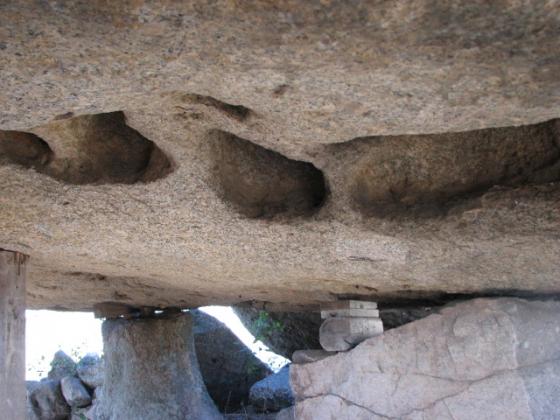






The monument from the rear




Tucked away in the most arcadian, peaceful valley in the world (possibly) just to the east of Tempio is Pascaredda tomba di giganti. Striding through seas of grasses and flowers following a path beside a tree lined stream of bucolic perfection, we arrived at a clearing surrounded by the gnarly ancient cork oaks to find this sweetest of tombi, complete with much of its barrow.
Thirteen out of 14 of its original capstones are still in place covering its deep tomb corridor. The curved arms of its forecourt stones sweep round elegantly each side of the stele. The stele is unusual in that it only has the bottom square with catflap – it lacks the arched top section that we’d seen at Coddhu Vecchju or Li Lolghi. Not that it mattered – this place was exquisite. Moth and I both looked for signs that it once has an arched topped, but found nothing to suggest it had.
With purple orchids in flower among the more than 16 species of flowering grasses and birdsong filling the warm scented air, this place is nothing less than orgasmic.
On the SS127 about 5km east of Tempio, and directly opposite a sign “Nuchis 1”, is the signposted turn to Pascaredda. Follow the track over the unmaned railway crossing and keep to the left fork as signposted. About 800m from the main road, there’s a large parking area, but we took the sharp right turn before it, and parked 250m or so further on, just before the riverlet mentioned in TME (OK for small cars, and there’s space to turn round just past the stream).
Free and open access.
We strolled up the path, with buzzing of thousands of insects filling our ears and butterflies and dragonflies flitting around, over the bridge and to the rear of the tomb.
A stunning spot! The trees are cork oaks and had had their bark stripped for the autumn harvest. Of the stele, only the bottom half is left; the 10 slabs on either side mark out the esedra, and a missing capstone lets you climb into the funeral corridor itself, and the sides of the corridor are buried with the earth bank rather than being exposed stone as we’d seen at other sites.
Again the granite had a pink tinge as we’d seen at Coddu Vecchiu and at the back of the funeral corridor, there’s a shelf, as we’d seen at Li Lolghi.
This was my first Sardinian site. It’s location on the Tempio to Calganius road is pretty much where Julian Cope describes it in the Megalithic European, unfortunately, due to Ryanairs meagre baggage allowance, I didn’t have the book with me and the site wasn’t on my map so I came across it by accident. Fortunately for me the Sardinians are pretty good at signposting their ancient monuments.
To reach the site you have to walk down a country lane and along a path on the edge of a field, you then cross over a fairly dodgy looking wooden bridge and the site is just in front of you in a cork wood. That sounds fairly straight forward, as it is, but the walk is absolutely beautiful and a great introduction to the sounds and smells of the Sardinian countryside, it also grounds you in a landscape ringed by sharp, craggy mountains with the Monte Limbara peaks rising to over 1300 metres.
Pascaredda is beautiful, you approach the site from the rear so the first thing I noticed was how neatly the stone capped mound fitted into the surrounding valley. As I moved around the mound the horned façade and forecourt came into view. The rocks of the façade had a definite pink tinge to them which would be something I would also encounter at Li Longhi. The carved portal stone is large but not huge, the proportions and symmetry of the monument are perfect and the carving is beautifully executed. After sitting and taking in the fact that I was actually here, I began to mooch around the mound and passageway. The mound appears to be constructed of small cobbles and earth. One of the cap stones had been removed from the passage, so I was able to slip down into the passage with relative ease. The passage was orientated east-west and was constructed in a dry stone style. It was interesting to note that the passage was independent of the façade, by this I mean that the large carved portal stone had been placed over an existing portal and the passage may have originally been a self-contained unit. This could imply that the façade was added at a later date. The rear (west) end of the chamber had a bench-like structure constructed by placing a large slab horizontally across the back of the chamber. Another feature, which was to become a occurring theme in the monuments I visited in Sardinia, was the use of water/wind eroded stones in the monuments.
Pascaredda was my first Tomba dei Giganti and I think it will always remain my favourite. It just all fits in so well, the walk to the site, the intact mound, the tomb, the lovely façade, the nearby stream, the mountains, Perfect!




